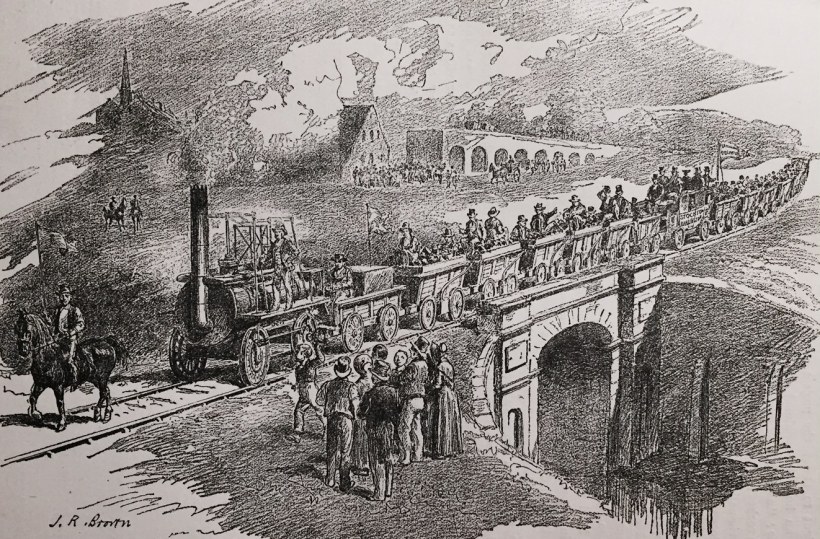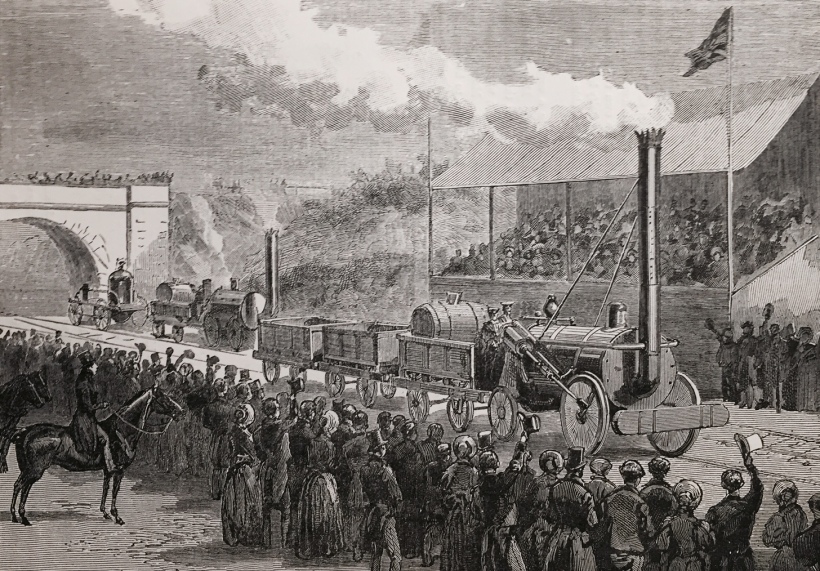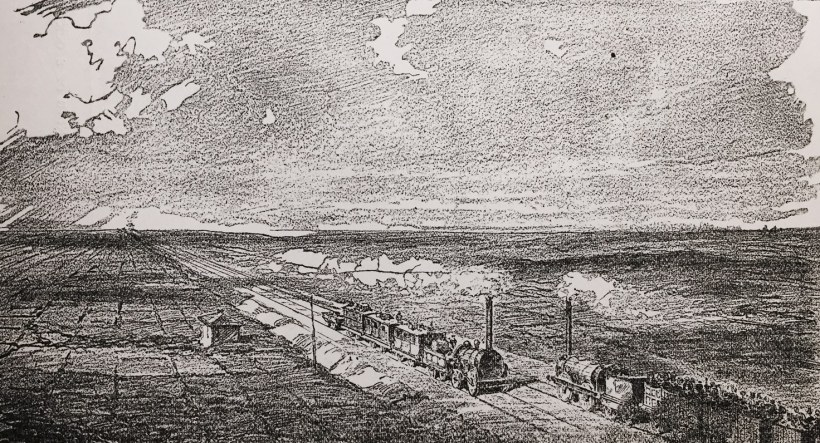
Although George Stephenson is rightly regarded as the “Father of Railways” for it was he who first made the locomotive a practical success for traffic the idea of a steam engine for traction had been previously worked out by several mechanical geniuses. Thus, Messrs. Trevethick and Vivian obtained a patent in 1802 for a high pressure locomotive engine, which, when the inventor had made certain improvements in it, was found capable of drawing a carriage on a circular railway at the rate of twelve miles an hour.
In 1813, Mr. William Hedley, of Wylam Colliery, made the first travelling locomotive engine, or substitute for animal power in the traction of coal waggons, ever see in the North. The coal was worked on the south side of the Tyne, conveyed under the river to the bottom of the shaft, and drawn up there; and from thence it was sent by the locomotives on a tramway to Lemington, a distance of above five miles. Each engine drew ten waggons, carrying eight chaldrons of coals, or 211 tons, and sometimes a dozen or more waggons were dragged by one engine. Strangers used to be struck with surprise and astonishment on seeing a locomotive engine moving majestically along the road at the rate of four or five miles an hour, drawing along from ten to fourteen loaded waggons; and their surprise was increased on witnessing the extraordinary facility with which the engine was managed. This invention was deemed a noble triumph of science, and so it really was, considering the time; but “Puffing Billy, “as Hedley’s locomotive was christened by the people near, is now only a curiosity, though it kept the road for a considerable time. The escapes of the jets of steam at high pressure, indeed, caused so much annoyance to the owners of horses in the neighbourhood, that the engine had to be stopped whenever a cart or carriage approached, and the working of the traffic was thus seriously interrupted, until Billy’s manners were improved by an ingenious arrangement for allowing the eteam to escape gradually.
George Stephenson, who had been for some time experimenting on the subject, constructed in 1815 the engine of which a figure ia here given, and which was a great improvement in many respects, and particularly in the simplicity of its mechanism, to Hedley’s engine. It weighed about eight tons, and could make a speed of nearly sixteen miles an hour in those days quite a marvel but with this disadvantage, that the chimney often became red-hot when running at that rate. But George was one of those extraordinary men to whom failure in any task, not physically impossible, is an unrecognised thing; and though his first locomotive was not very efficient, he was never satisfied till he had improved it so far as to come up somewhat near his own ideal. Mr. Goldworthy Gurney’s grand improvement of the steam blast was utilised by him to carry his experiments to a triumphal issue.
In 1820, Stephenson was appointed engineer for the construction of the Stockton and Darlington Railway; and when that line was opened on the 27th September, 1825, his locomotive engine was called into requisition, and drew a train of thirty-eight carriages, fully loaded with coals, goods, and passengers, exclusive of the tender with coals and water, a distance of eight and three-quarter miles in sixty-five minutes, the speed in some parts being frequently twelve miles an hour, and, in one place for a short distance, near Darlington, fifteen miles per hour. On this occasion the fields on each side of the railway may be said to have been literally covered with ladies and gentlemen on horseback, and pedestrians of all kinds. A man rode in front carrying a flag, as may be seen in our engraving.
The rapid growth of the trade of South Lancashire, together with the unpopular management of the Bridgewater Canal, gave rise in 1821 to the project of a railway between Liverpool and Manchester. Stephenson, who had meanwhile fully established his reputation as a practical man, was chosen engineer by the directors, with a salary of £1,000 a year. He proposed to work the line with locomotive engines going at the rate of twelve miles an hour an idea which was held up by some incredulous critics as sufficient to stamp the project as a bubble. “Twelve miles an hour!” exclaimed a writer in the Quarterly Review: “as well trust oneself to be fired off from a Congreve rocket!”

It had been originally contemplated to work the trains by horses; but locomotives having been long used in conveying coal in the Newcastle district, it was believed that they might be used to draw passengers with advantage. The company consequently offered a reward of £500 to the maker of the best locomotive, particularising certain conditions necessary to be fulfilled. The trial took place on the 6th October, 1829, at Rainhill, near Liverpool, on a level piece of the railway one mile and three quarters in length. The distance to be run was seventy miles, backwards and forwards, thus giving forty stoppages. The following engines appeared: The “Novelty,” made by Messrs. Braithwaite and Ericsson, of London, but this was withdrawn, in consequence of some derangement in her pipes shortly after starting; the “Rocket,” made by Messrs. Robert Stephenson and Co., of Newcastle, weighing 4 tons 9 cwt., which did the seventy miles in six and a-half hours an average speed of somewhat over five and a-half minutes per mile and so gained the prize; the “Perseverance,” made by Mr. Burstal, of Leith; and the “Sans Pareil’made by Mr. Timothy Hackworth, of Darlington. The two latter came in second and third. The “Rocket” afterwards astonished everybody by drawing a carriage containing from twenty to thirty passengers up the Whiston inclined plane, rising 1 in 96, at rates of from fifteen to eighteen miles per hour. Yet, marvellous as was the “Rocket” in its day, it would now be looked upon by railway engineers as a pretty toy. For it was soon discovered that the bite and steadiness of the locomotive on the rails were of so much importance as to counteract the disadvantage of the vis inertia of increased weight; and therefore locomotives began to be made always heavier and heavier, till some of them are now, we believe, up-wards of twenty tons weight.

One of the most difficult parts of the Liverpool and Manchester line to make was that over Chat Moss, a huge bog, between Bury Lane and Patricroft, comprising an area of twelve square miles, so soft as to yield to the foot of man or beast, and in many parts so fluid that an iron rod laid upon the surface would sink out of sight by its own weight. It varied from ten to thirty-five feet in depth, and the bottom was composed of sand and clay. On the eastern border, for about a mile and a-half, the greatest difficulty in the construction of the road occurred. Here an embankment of about twenty feet above the natural level was formed, the weight of which, resting on a soft base, pressed down the original surface; many thousand cubic yards gradually and silently disappeared before the desired level was attained; but, by degrees, the whole mass beneath and on either side of this embankment became consolidated by the superincumbent and lateral pressure, and the work was finally completed at less expense than any other part of the line. Hurdles of brushwood and heath were placed under the wooden sleepers, which supported the rails over the greater part of this moss; so that the road might be said to float on the surface. And on the 1st of May, 1830, the “Rocket” steam-engine, with a carriage full of company, passed over the roadway, along the whole extent of Chat Moss, thus affording the first triumphant proof of the possibility of forming this much-contested line.
WILLIAM BROCKIE.


